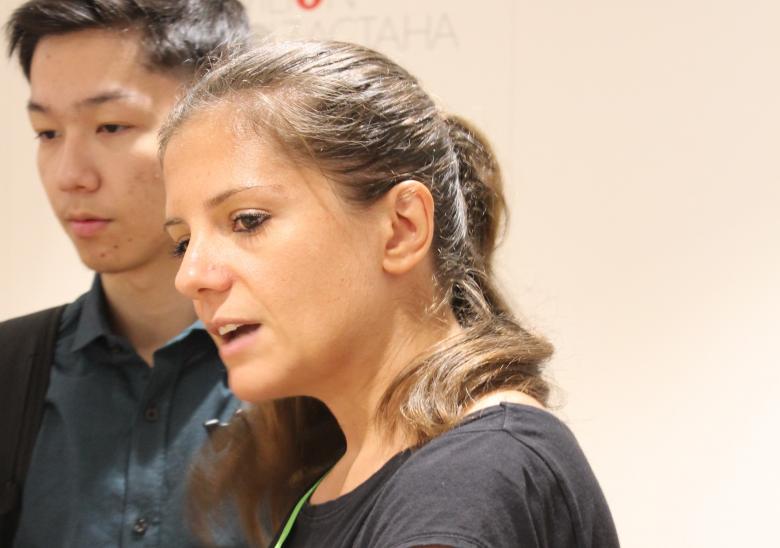Energy sources: choosing wisely demands information
Why does wind power costs more than coal? What does it change if a country uses oil instead of solar energy for heating its houses? Swiss Pavilion visitors could learn about all this in July thanks to the “Energy Game” displayed in the swissnex Lab.
Aiming at raising the participants’ awareness about the impact of the use of certain energy sources on the environment and on everyday life, the workshop is developed and conducted by the Università della Svizzera Italiana’s (USI – in Lugano, an Italian-speaking region, on the South of Switzerland).
The 15-minute game, which was already conducted in several other places – at the 2015 Milan Expo, for example – also teaches the players that receiving more accurate information about a given problem (here, energy production) can impact one’s decisions.
Knowing impacts choices
“The Energy Game is aimed at making participants think about energy sources and the consequences of energy on the environment and also on the way we make decisions, and how learning can change our way of thinking” explains Alessandra Motz, PhD candidate at the Università della Svizzera Italiana.
Each participant slips into the shoes of the ruler of an imaginary country, and decides how much electricity he wants produce with each of the available energy generation technologies. The aim of this four-staged game is to demonstrate that comparing one’s decisions to others’ and learning about energy impacts one’s choices about it.
During the first stage, participants receive a glass full of small pebbles. Then, they are asked to choose, without any prior information, which source of energy they would rather use to generate electricity for their imaginary country.
Six technologies to choose from
There are six technologies to choose from, identified by the primary energy source: solar, wind, hydroelectric energy, natural gas, coal, and nuclear energy. Without seeing what other people chose, they mark their vote by pouring all of- or some of their pebbles in the tube which bears the label of the wished energy source. “Any answer is fine, the important thing is to think first before making a decision”, shares Dr. Motz.
The next step asks the players to have a look at the results of the vote: the can look at the plastic tubes which are filled with the pebbles. Needless to say, the preferred energy sources are where there are the most pebbles.
Then, the game manager will give information to the participants, such as: wind energy is far cleaner than coal-burning stations… but also costs a lot more money. Or: solar energy produces far less CO2 emissions, but is also a lot more expensive than oil.
After receiving these facts, the players are asked to vote again, while taking the information they just got. And last but not least, they can compare the results of the previous votes with the help of the game manager.
Clean energies perceived to be underused in Kazakhstan
Then, how did the Expo visitors vote? In the first vote, the participants asked on average for a very large contribution from renewable energy sources, among which mostly solar and wind. “Probably because Kazakhstan is very rich in wind and sun energy” Alessandra Motz points out.
In the second vote participants still asked for a cleaner electricity production. However, their choices were balanced in order to include a larger contribution of hydroelectric and nuclear energy, at the expense of sun and wind. The share of fossil fuels also experienced a slight reduction, with coal gaining one percentage point at the expense of the cleaner, but more expensive natural gas. The mix resulting from the second vote achieved a small reduction in terms of emissions (92 g CO2 eq./kWh) and a larger drop in terms of costs (11.6 cent USD/kWh) as compared to that resulting from the first vote.

Environmental issues are important
On the whole, the USI team witnessed “a strong sensitivity toward environmental issues, and a strong interest in new renewable energy sources, which are perceived as underexploited in Kazakhstan”, they write on their website. Although the Expo visitors were “ready to bear an increase in generation costs in order to achieve a reduction in greenhouse gas emissions, they were also ready to reconsider their initial preferences, and accept a different mix yielding a smaller cost reduction.”
No decision comes easy
The main message of the Energy Game is that no decision is easy when it comes to choosing one energy source over the other. It helps the participants understand why some countries would choose an “unclean” energy over a greener one because the costs or the CO2 emissions are lower.
“What we really like the visitors to take with them after this game is that informing yourself before taking a decision is important. Some choices can’t be made based on the emotions and ideas and that a lot of factors need to be taken into account” Alessandra Motz rounds off.
Follow Alessandra Motz to see how the game works in this video:
Read more: http://www.ire.eco.usi.ch/en/expo-astana
